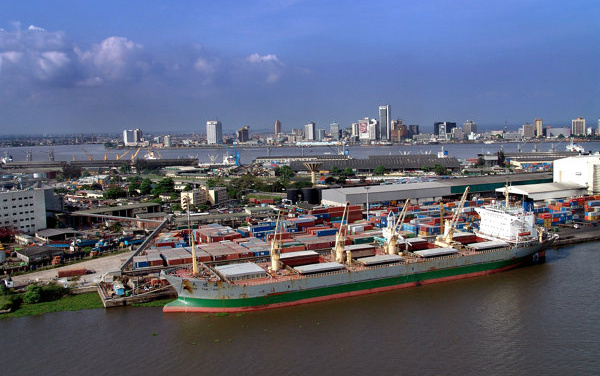A port complex in Lagos, Nigeria, September 11, 2020 (Getty)
On January 1, Africa’s states began trading under the long-awaited African Continental Free Trade Area, covering an estimated population of 1.3 billion with a combined GDP of $3.4 trillion.
The AfCFTA is already the largest free trade area in the world. But for success, much much needs to be done.
For many on the continent, the AfCFTA represents the start of a new era, the first step towards an integrationist ambition long held since the independence era. AfCTA Secretary-General Wamkele Mene hails the agreement as an opportunity to transform the African economy and further establish independence:
Africa continues to be trapped in a colonial economic model, which requires that we aggressively implement the AfCFTA as one of the tools for effecting a fundamental structural transformation of Africa’s economy.
See also Greening Intra-Regional Trade: How to Achieve Sustainable Industrialization in Africa
The AfCFTA eliminates tariffs on 90% of goods produced in Africa, attempts to address non-tariff barriers, and seeks the free movement of people on the continent. It has the potential to increase intra-African trade by about 50%.
The AfCFTA is designed as an important step towards the industrialization of Africa, with development of the manufacturing sector, in part by encouraging much-needed foreign investment and by reducing the continent’s overreliance on raw materials exports. For Africa’s small- and medium-sized enterprises, the AfCFTA presents an opportunity for growth, although measures must ensure that those in larger African economies do not dominate their neighboring markets.
It is also hoped that the agreement will elevate the continent’s informal economies, responsible for 66% of the employment in sub-Saharan Africa, according to some estimates. This would especially benefit African women, thought to account for 70% of cross-border traders in the informal sector.
Ultimately, AfCFTA is expected to lift 30 million Africans out of poverty.
Now for Implementation
AfCFTA has been signed by 54 of the 55 members of the African Union, and ratified by 36. But will governments effectively implement the agreement?
A big cause for concern is the inequality between African economies. Three countries — Nigeria, Egypt, and South Africa — account for more than 50% of the continent’s GDP. Smaller neighbors will struggle to present the agreement to sceptical populations who fear they will be overrun by dominant enterprises based abroad. The smaller economies also tendto rely more on intra-African tariff revenues, which the agreement will reduce in the short term. Given the protectionism in several African countries, as well as worries about cross-border smuggling, the political will of African governments to liberalize might become a significant hurdle.
Fundamental aspects of the agreement still have to be ironed out, particularly the rules of origin. In global value chains, determining which products originate in Africa is a difficult task which can make or break the agreement. Too strict a formulation will make the Free Trade Area much less viable for SMEs and hinder compliance with rules. But the agreement must be precise enough to guarantee that the area is not exploited by foreign exporters seeking an easy route into African markets.
An effective formulation will encourage African industries to source cheaper inputs from neighboring countries. Ultimately, however, the ability of African states to participate in the FTA will be a question of infrastructure and substantial foreign investment. Poor transport links, inadequate access to utilities, and fluctuating fuel prices make it easier for many African enterprises to export to the EU, US, and China rather than to other African countries.
AfCFTA and The World
China, the top investor in African infrastructure, is likely to play an important role in making the FTA functional. However, Beijing is expected to slow down or even retract its lending, largely due to backlash over the ongoing debt crisis. Pressures may also mount from ongoing tensions between the US and China.
The Biden Administration is reasserting Washington as a global actor, but aside from a joint US-African Union statement, Washington’s response to the AfCFTA has been lackluster. Recent Americans negotiations with Kenya were met with criticism from those who believe such agreements undermine the implementation of the AfCFTA.
Currently the AfCFTA does not include any common eternal tariff barriers, leaving it up to individual governments to decide how to negotiate between the FTA and external trade relations. While intra-African investments are expected to increase in the short term African states will still have to rely largely on investment and cooperation from abroad.
Much like African states themselves, the international community needs to be willing to back up the integrative efforts of AfCFTA for it to work as intended. It is not a requirement of investment but of quality investment led by good governance and coordination, locally and globally.
All the AfCFTA’s prerequisites for success are precisely what it has to offer. Political cooperation, economic integration, and coordinated development efforts are both the means and the end. The foundation has been laid for both African states and foreign powers to commit to a pan-African economic vision.






